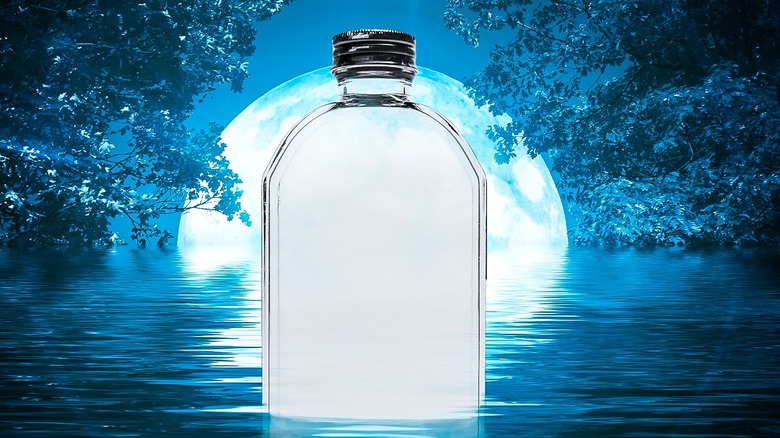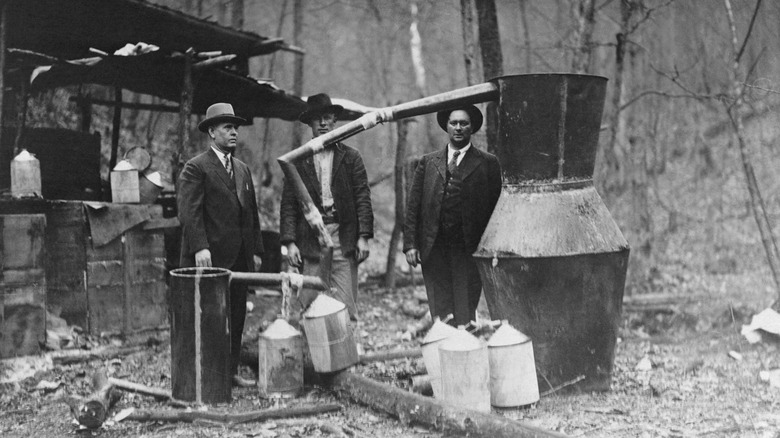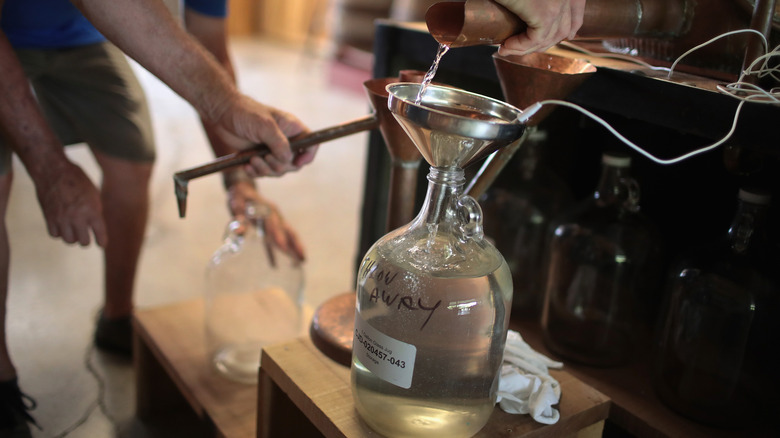How Moonshine Got Its Whimsical Name
Head to the liquor store, and there's an impressive range of spirits styles to browse. Most bottles fall into neat categories, separated into common names like tequila, vodka, and more. Then there's moonshine — just the name itself sticks out, invoking associations of something especially stiff and backed by lore. Although technically a term for any booze made illegally, the term's become intertwined with a strong, corn-based unaged whiskey. So, how did this style of spirit even attain such a memorable name?
Well, the word moonshine has been around since the 15th century, originally referring to something that's like an apparition, existing without substance. It wasn't until the late 18th century that it started to reference smuggled alcohol, quite literally being transported during the night. A whole culture around the activity emerged in England, with crafters of the spirit called moonshiners.
The practice carried over to the U.S. and grew as a result of a new alcohol taxation. More slang (some unfavorable) like rotgut, hooch, and skull pop became associated with the term, especially gaining cultural relevance during Prohibition. Today, crafting distilled spirits without a license is still illegal in the U.S. However, The Alcohol and Tobacco Tax and Trade Bureau now recognizes moonshine as a special spirit style, although its legality is still complicated.
The practice of moonshine dates back centuries
Although strongly interlinked with the Prohibition era, the culture surrounding moonshine stretches further back. Moonshine traces back to England when smugglers would move illegal liquor on the coast in the late 1700s. Only a few years after the U.S. gained independence, the concept started in Pennsylvania, too, due to dissatisfaction with a liquor tax. This unrest culminated in the Whiskey Rebellion, which caused settlers to relocate and is why Kentucky is the bourbon capital of the U.S.
Moonshine production continued through the 19th century, with periods of taxation and restriction spurring more illegal distillation. A unique culture and tradition came to be established, creating new versions of unaged whiskey and brandies and more. The South became a prevalent region, but clandestine spirit creation was especially common in New York, especially around the turn of the 20th century.
Soon, Prohibition was enacted, and the frequency of moonshine production exploded. At this time, many of the underground spirit's legends were created, including its links to NASCAR racing. Producers devised new ways of making larger batches of more potent booze, which sometimes increased the dangers of poorly made spirits. Illegal moonshine production continued into the 1970s until health warnings and other factors stopped the practice. In the 21st century, storied producers — as well as newcomers — established legal distilleries, which gave ode to the styles of liquor that were created under the moonshine name.
The term moonshine encompasses many alcohol styles
Moonshine's illegal nature may bring associations with imperfectly produced liquor that can even carry a bit of danger. Of course, there is a risk to consuming any spirit that's not regulated, but the stuff you'll find on store shelves and in tasting rooms is legal and safe. In fact, the term's less restrictive nature even adds to its enthrallment. For example, Scotch is made from a regulated assortment of ingredients, but moonshine can have any distillation base. Plus, there are no requirements for additives and the final proof, making it quite a versatile spirit.
The most widespread form of moonshine is made from corn, with malted barely added to the mash to create sugar. Barley and rye are also plausible bases, all crafting what's basically unaged whiskey. Sometimes, even more sugar can be added during mashing, or the grain base left out entirely, leading to a more rum-like beverage. Alternatively, the distillation can start from fruit, too, producing an apple brandy-like liquor.
The result is usually high in proof and spends little or no time in the barrel, which furthers its harshness. However, some producers craft renditions more akin to vodka or showcase the flavor of the grains. Plus, there's now an extensive range of flavored moonshines, which pack in everything from fruit to bacon to pickles. So the name moonshine in the modern age actually refers to quite a few different spirits.


